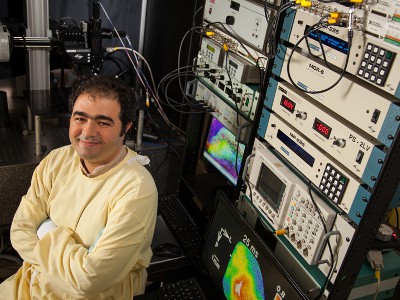

The Canadian Centre for Behavioural Neuroscience (CCBN) at the University of Lethbridge in Alberta has unveiled its new optical imaging lab, a facility that allows researchers to conduct research relevant to unlocking the secrets of the human brain, and studying disorders like stroke and Alzheimer’s disease.
Using transgenic, genetically modified mice, Dr. Majid Mohajerani and his team are finally seeing the work of the past two and a half years produce results that will eventually improve treatments for human patients.
“We know that some diseases in our nervous systems are happening due to changes in particular genes. Researchers have been identifying those genes and translocating them into a mouse genome,” says Mohajerani. “When the mouse grows up, it looks like the gene that affects humans also does something similar in a mouse brain. Now we can use the mouse as a model to study that type of disease.”
Funding for the CCBN began in 2008, with a major investment of Polaris funds from Alberta Innovates: Health Solutions, the University of Lethbridge, Dr. Bruce McNaughton and Dr. Rob Sutherland, and two infrastructure grants from the Canada Foundation for Innovation.
The Centre has NeuroInvestigations Inc. as an industrial partner and currently holds 16 principal investigators working on systems-level neuroscience, including human neuropsychology, cognitive neuroscience, and neuroimaging.
The lab now allows researchers to study specific areas of the brain in transgenic mice, watching how neurons react during particular behaviours.
“Using this novel combination of genetics, optical imaging and bioengineering, we can watch thousands of neurons over the course of days and months. This will allow us to study how different parts of the brain communicate and work with each other, and how changes in brain circuitry can lead to mental disorders like Alzheimer’s disease,” says Mohajerani. “I have invested a lot of effort to bring our infrastructure to acceptable levels. We can consider ourselves a world-class neuroscience institution.”
Post-doctoral researcher Dr. Michael Kyweriga is using the lab to study tinnitus, to determine if the parietal association area of the brain is involved in a task that requires a transgenic mouse to discriminate between two auditory tones.
“Many people are aware of the cocktail party effect, which is when you’re in a noisy environment and you’re talking to your friend but there’s all these distracting sounds,” says Kyweriga. “You are able to tune out those distracting sounds. That’s a form of attention called top-down control, where you try to suppress other inputs and pay attention to what your friend is saying. How the brain does this is not well understood.”
Post-doctoral researcher Dr. Maurice Needham conducts studies using lasers to view neuronal activity, and is in charge of making sure the lab’s equipment, including two-photon microscopes, run smoothly.
“We are one of only two labs in Canada with this imaging set-up, making us competitive on the world stage for neuroscience research,” says Needham. “These systems, along with the new two-photon tomography system, will elevate this research centre’s technical abilities to compete with the best universities in the world.”
Two-and-a-half years in the making, Dr. Mohajerani’s lab is now in a position to give the University of Lethbridge world-leading status in the study of behavioural neuroscience.
Leave a Reply
You must be logged in to post a comment.



 Share
Share Tweet
Tweet Share
Share




Comment